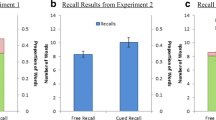Abstract
Most reading research investigating the role of phonology in word recognition has focused on studies employing an individual word as the sole stimulus. The bulk of such research has offered support for the phonological recoding hypothesis, the conjecture that access to a printed word’s meaning requires activation of the word’s phonology (i.e., meaning is not typically activated via orthography alone). A criticism of such studies is that by presenting participants with only a single word on each experimental trial (a nonecological manipulation), participants may alter their typical strategy of reading in such a way as to artificially favor the phonological recoding hypothesis. The present study avoided a focus on single words by requiring participants to read sentences and paragraphs for comprehension. Experiment 1 showed that, in reading a paragraph of connected sentences, eliminating a letter in a word that altered the phonology was more deleterious than eliminating a letter that did. Experiment 2 focused on the reading of each sentence itself rather than on the paragraph and provided additional control conditions. The results were similar to those of Experiment 1, consistent with the phonological recoding hypothesis.
Similar content being viewed by others
References
Baayen, R. H., Piepenbrock, R., & van Rijn, H.(1993). The CELEX lexical database, [CD-ROM]. Philadelphia: University of Pennsylvania, Linguistic Data Consortium.
Brown, J., Goodman, K. S., & Marek, A. M.(1996). Studies in miscue analysis: An annotated bibliography. Newark, DE: International Reading Association.
Goodman K.S.: A linguistic study of cues and miscues in reading. Elementary English 42, 639–643 (1965)
Coltheart M., Rastle K., Perry C., Langdon R., Ziegler J.: DRC: A dual route cascaded model of visual word recognition and reading aloud. Psychological Review 108, 204–256 (2001). doi:10.1037/0033-295X.108.1.204
Coltheart V., Laxon V., Richard M., Elton C.: Phonological recoding in reading for meaning by adults and children. Journal of Experimental Psychology. Learning, Memory, and Cognition 14, 387–397 (1988). doi:10.1037/0278-7393.14.3.387
Daneman M., Stainton M.: Phonological recoding in silent reading. Journal of Experimental Psychology: Learning, Memory and Cognition 17, 618–632 (1991)
Greene H.: The control of fixation duration in visual search. Perception 35, 303–315 (2006). doi:10.1068/p5329
Frisson S., Rayner K., Pickering M.J.: Effects of contextual predictability and transitional probability on eye movement during reading. Journal of Experimental Psychology. Learning, Memory, and Cognition 31, 862–877 (2005). doi:10.1037/0278-7393.31.5.862
Katz L., Lee C.H., Tabor W., Frost S.J., Mencl W.E., Sandak R. et al.: Behavioral and neurobiological effects of printed word repetition in lexical decision and naming. Neuropsychologia 43, 2068–2083 (2005). doi:10.1016/j.neuropsychologia.2005.03.022
Lee C.H., Turvey M.: Silent letters and phonological priming. Journal of Psycholinguistic Research 32, 313–334 (2003). doi:10.1023/A:1023595619040
Lee Y., Binder K., Kim J., Pollatsek A., Rayner K.: Activation of phonological codes during eye fixations in reading. Journal of Experimental Psychology. Human Perception and Performance 25, 948–964 (1999). doi:10.1037/0096-1523.25.4.948
Lesch M.F., Pollatsek A.: Automatic access of semantic information by phonological codes in visual word recognition. Journal of Experimental Psychology. Learning, Memory, and Cognition 19, 285–294 (1993). doi:10.1037/0278-7393.19.2.285
Lukatela G., Eaton T., Lee C.H., Carello C., Turvey M.: Nonword-nonword pseudohomophonic priming. Journal of Experimental Psychology. Human Perception and Performance 28, 3–21 (2002). doi:10.1037/0096-1523.28.1.3
Lukatela G., Turvey M.T.: Similar attentional, frequency, and associative effects for pseudohomophones and words. Journal of Experimental Psychology. Human Perception and Performance 19, 166–178 (1993). doi:10.1037/0096-1523.19.1.166
Lukatela G., Turvey M.T.: Visual lexical access is initially phonological2. evidence from phonological priming homophones, and pseudohomophones. Journal of Experimental Psychology. General 123, 331–353 (1994). doi:10.1037/0096-3445.123.4.331
Martin R.: Components of short-term memory and their relation to language processing: Evidence from neuropsychology and neuroimaging. Current Directions in Psychological Science 14, 204–208 (2005). doi:10.1111/j.0963-7214.2005.00365.x
McCusker L., Gough P.B., Bias R.G.: Word recognition inside out and outside in. Journal of Experimental Psychology. Human Perception and Performance 7, 538–551 (1981). doi:10.1037/0096-1523.7.3.538
Van Orden G.C., Goldinger S.D.: Interdependence of form and function in cognitive systems explains perception of printed words. Journal of Experimental Psychology. Human Perception and Performance 20, 1269–1291 (1994). doi:10.1037/0096-1523.20.6.1269
White S.J., Liversedge S.P.: Linguistic and nonlinguistic influences on the eyes’ landing positions during reading. The Quarterly Journal of Experimental Psychololgy 59, 760–782 (2006). doi:10.1080/02724980543000024
Author information
Authors and Affiliations
Corresponding author
Rights and permissions
About this article
Cite this article
Lee, C.H. Testing the Role of Phonology in Reading: Focus on Sentence Processing. J Psycholinguist Res 38, 333–344 (2009). https://doi.org/10.1007/s10936-008-9092-0
Received:
Accepted:
Published:
Issue Date:
DOI: https://doi.org/10.1007/s10936-008-9092-0




